List of chancellors of Germany
The chancellor of Germany[1] is the political leader of Germany and the head of the federal government. The office holder is responsible for selecting all other members of the government and chairing cabinet meetings.[2]
- Top left: Otto von Bismarck was the first chancellor of Germany with the creation of the North German Confederation and later the German Empire.
- Top right: Konrad Adenauer was the first chancellor of the Federal Republic of Germany.
- Bottom left: Helmut Kohl was chancellor during the period of German reunification in 1990.
- Bottom right: Angela Merkel was the first female chancellor of Germany.
The office was created in the North German Confederation in 1867,[3] when Otto von Bismarck became the first chancellor. With the unification of Germany and establishment of the German Empire in 1871, the Confederation evolved into a German nation-state and its leader became known as the chancellor of Germany.[4] Originally, the chancellor was only responsible to the emperor. This changed with the constitutional reform in 1918, when the Parliament was given the right to dismiss the chancellor. Under the 1919 Weimar Constitution the chancellors were appointed by the directly elected president, but were responsible to Parliament.[5]
The constitution was set aside during the 1933–1945 Nazi dictatorship. During Allied occupation, no independent German government and no chancellor existed; and the office was not reconstituted in East Germany, thus the head of government of East Germany was chairman of the Council of Ministers. The 1949 Basic Law made the chancellor the most important office in West Germany, while diminishing the role of the president.[1]
North German Confederation (1867–1871)
- Federal Chancellor of the North German Confederation
The North German Confederation came into existence after the German Confederation was dissolved following the Prussian victory in the Austro-Prussian War of 1866. The chancellor was appointed by the Bundespräsidium, a position that was held constitutionally by the Prussian king.[3]
| Portrait | Name | Took office | Left office | Time in office | Political Party | |
|---|---|---|---|---|---|---|
 |
Otto von Bismarck (1815–1898) |
1 July 1867 |
21 March 1871 |
3 years, 263 days | Non-partisan | |
German Reich (1871–1945)
German Empire (1871–1918)
- Reich Chancellor of the German Reich
The German Empire was born out of the North German Confederation as result of the Franco-Prussian War (1870/71). The Präsidium (the Prussian king), which now had also the title Emperor, named the chancellor.[4]
Political parties: None Centre
| # | Portrait | Name | Took office | Left office | Time in office | Political party | Cabinet | |
|---|---|---|---|---|---|---|---|---|
| 1 |  |
Otto von Bismarck (1815–1898) |
21 March 1871 |
20 March 1890 |
18 years, 364 days | Non-partisan | Bismarck | |
| 2 | 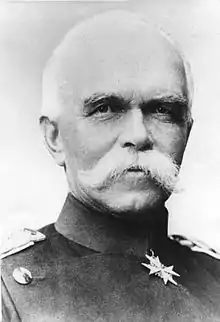 |
Leo von Caprivi (1831–1899) |
20 March 1890 |
26 October 1894 |
4 years, 220 days | Non-partisan | Caprivi | |
| 3 | _773.jpg.webp) |
Chlodwig zu Hohenlohe-Schillingsfürst (1819–1901) |
29 October 1894 |
17 October 1900 |
5 years, 353 days | Non-partisan | Hohenlohe-Schillingsfürst | |
| 4 | (b).jpg.webp) |
Bernhard von Bülow (1849–1929) |
17 October 1900 |
14 July 1909 |
8 years, 270 days | Non-partisan | Bülow | |
| 5 | .jpg.webp) |
Theobald von Bethmann Hollweg (1856–1921) |
14 July 1909 |
13 July 1917 |
7 years, 364 days | Non-partisan | Bethmann Hollweg | |
| 6 | .jpg.webp) |
Georg Michaelis (1857–1936) |
14 July 1917 |
1 November 1917 |
110 days | Non-partisan | Michaelis | |
| 7 | .jpg.webp) |
Georg von Hertling (1843–1919) |
1 November 1917 |
30 September 1918 |
333 days | Centre Party | Hertling | |
| 8 | 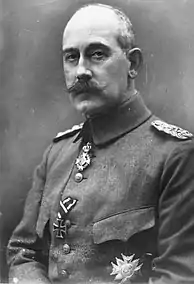 |
Max von Baden (1867–1929) |
3 October 1918 |
9 November 1918 |
37 days | Non-partisan | Baden | |
Weimar Republic (1918–1933)
On 9 November 1918, Chancellor Max von Baden handed over his office to Friedrich Ebert. Ebert continued to serve as head of government during the three months between the end of the German Empire in November 1918 and the first gathering of the National Assembly in February 1919 as Chairman of the Council of the People's Deputies, until 29 December 1918 together with USPD Leader Hugo Haase.[6]
The Weimar Constitution of 1919 set the framework for the Weimar Republic. The chancellors were officially installed by the president; in some cases the chancellor did not have a majority in parliament.[1][5]
Political parties: SPD Centre DVP Nazi None
| # | Portrait | Name | Took office | Left office | Time in office | Political party | Cabinet | Reichstag | |
|---|---|---|---|---|---|---|---|---|---|
| 9 | 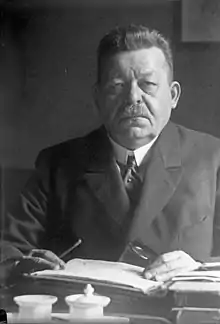 |
Friedrich Ebert (1871–1925) |
9 November 1918 |
13 February 1919 |
96 days | Social Democratic Party (SPD) |
Council of the People's Deputies SPD–USPD (as of 29 December 1918 SPD alone) |
– | |
| 10 | 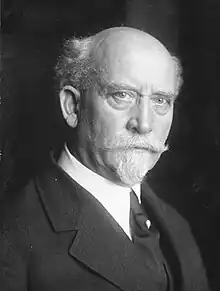 |
Philipp Scheidemann (1865–1939) |
13 February 1919 |
20 June 1919 |
127 days | Social Democratic Party (SPD) |
Scheidemann SPD–DDP–Z (Weimar Coalition) |
Nat.Ass. (Jan.1919) | |
| 11 | 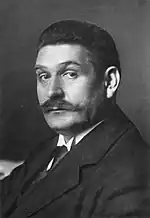 |
Gustav Bauer (1870–1944) |
21 June 1919 |
26 March 1920 |
273 days | Social Democratic Party (SPD) |
Bauer SPD–DDP–Z (Weimar Coalition) | ||
| 12 | 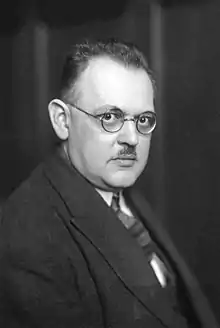 |
Hermann Müller (1876–1931) |
27 March 1920 |
21 June 1920 |
86 days | Social Democratic Party (SPD) |
Müller I SPD–DDP–Z (Weimar Coalition) |
Nat.Ass. (Jan.1919) | |
| 13 | 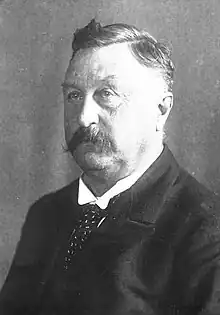 |
Constantin Fehrenbach (1852–1926) |
25 June 1920 |
10 May 1921 |
319 days | Centre Party | Fehrenbach Z–DDP–DVP |
1 (Jun.1920) | |
| 14 |  |
Joseph Wirth (1879–1956) |
10 May 1921 |
22 November 1922 |
1 year, 196 days | Centre Party | Wirth I Z–SPD–DDP (Weimar Coalition) | ||
| Wirth II Z–SPD–DDP (Weimar Coalition) | |||||||||
| 15 |  |
Wilhelm Cuno (1876–1933) |
22 November 1922 |
12 August 1923 |
263 days | Non-partisan | Cuno Ind.–DVP–DDP–Z–BVP | ||
| 16 |  |
Gustav Stresemann (1878–1929) |
13 August 1923 |
30 November 1923 |
109 days | German People's Party | Stresemann I DVP–SPD–Z–DDP | ||
| Stresemann II DVP–SPD–Z–DDP | |||||||||
| 17 | .jpg.webp) |
Wilhelm Marx (1863–1946) |
30 November 1923 |
15 January 1925 |
1 year, 46 days | Centre Party | Marx I Z–DVP–BVP–DDP | ||
| Marx II Z–DVP–DDP |
2 (May 1924) | ||||||||
| 18 | 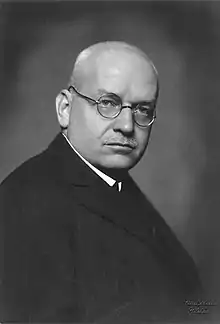 |
Hans Luther (1879–1962) |
15 January 1925 |
12 May 1926 |
1 year, 117 days | Non-partisan | Luther I DVP–DNVP–Z–DDP–BVP |
3 (Dec.1924) | |
| Luther II DVP–Z–DDP–BVP | |||||||||
| 19 | .jpg.webp) |
Wilhelm Marx (1863–1946) |
17 May 1926 |
28 June 1928 |
2 years, 42 days | Centre Party | Marx III Z–DVP–DDP–BVP | ||
| Marx IV Z–DNVP–DVP–BVP | |||||||||
| 20 |  |
Hermann Müller (1876–1931) |
28 June 1928 |
27 March 1930 |
1 year, 272 days | Social Democratic Party (SPD) |
Müller II SPD–DVP–DDP–Z–BVP |
4 (May 1928) | |
| 21 | 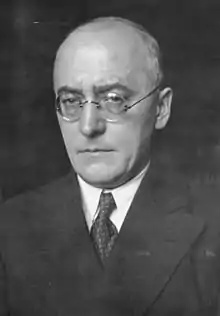 |
Heinrich Brüning (1885–1970) |
30 March 1930 |
30 May 1932 |
2 years, 61 days | Centre Party | Brüning I Z–DDP–DVP–WF–BVP–KVP |
5 (Sep.1930) | |
| Brüning II Z–DSP–BVP–KVP–CLV | |||||||||
| 22 | (2).jpg.webp) |
Franz von Papen (1879–1969) |
1 June 1932 |
3 December 1932 |
185 days | Non-partisan | Papen Ind.–DNVP |
6 (Jul.1932) | |
| 23 | 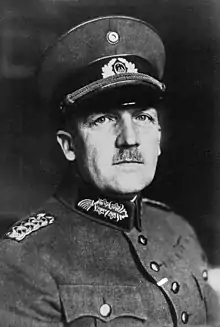 |
Kurt von Schleicher (1882–1934) |
3 December 1932 |
30 January 1933 |
58 days | Non-partisan | Schleicher Ind.–DNVP |
7 (Nov.1932) | |
| 24 |  |
Adolf Hitler (1889–1945) |
30 January 1933 |
24 March 1933 |
53 days | National Socialist German Workers' Party |
Hitler NSDAP – DNVP |
8 (Mar. 1933) | |
Nazi Germany (1933–1945)
Soon after Adolf Hitler was appointed as chancellor in 1933, the German Reichstag (parliament) passed the so-called Enabling Act (German: Ermächtigungsgesetz), officially titled "Law for Removing the Distress of People and Reich" (German: Gesetz zur Behebung der Not von Volk und Reich), which effectively gave the chancellor the power of a dictator. This event marked the end of the Weimar Republic and the beginning of Nazi Germany.[7] Hitler thereupon destroyed all democratic systems and consolidated all power to himself. After the death of president Paul von Hindenburg in 1934, Hitler merged the offices of chancellor and president in his own person and called himself Führer und Reichskanzler.
Political parties: Nazi
| # | Portrait | Name | Start | End | Time in office | Political Party | Cabinet | Reichstag[lower-alpha 1] | |
|---|---|---|---|---|---|---|---|---|---|
| 25 |  |
Adolf Hitler (1889–1945) |
24 March 1933 |
30 April 1945 |
12 years, 37 days | National Socialist German Workers' Party |
Hitler NSDAP |
9 (Nov. 1933) | |
| 10 (Mar. 1936) | |||||||||
| 11 (Apr. 1938) | |||||||||
| 26 | 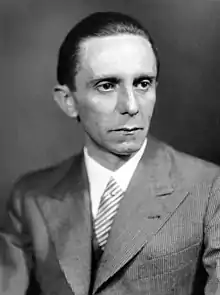 |
Joseph Goebbels (1897–1945) |
30 April 1945 |
1 May 1945 |
1 day | National Socialist German Workers' Party |
(Cabinet nominated in Hitler's testament but never convened) NSDAP |
— | |
| 27 | 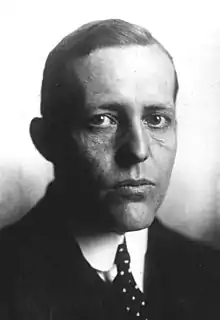 |
Lutz Graf Schwerin von Krosigk (1887–1977) |
2 May 1945 |
23 May 1945 |
21 days | National Socialist German Workers' Party |
Schwerin von Krosigk NSDAP |
— | |
Federal Republic of Germany (1949–present)
In 1949, two separate German states were established: the Federal Republic of Germany (known as West Germany) and the German Democratic Republic (known as East Germany). The list below gives the chancellors of West Germany; the government of East Germany was headed by the chairman of the Council of Ministers.[8] In 1990, East Germany was dissolved as it merged with West Germany; Germany was reunified. It retained the name of the Federal Republic of Germany.[9]
Political parties: CDU (4) SPD (4) Independent (1)
- No elections held during World War II. Last convened on 26 April 1942.
- No party membership; but affiliated with the CDU.[10] Later on, Erhard briefly became the leader of the CDU from 1966 to 1967.
Timeline
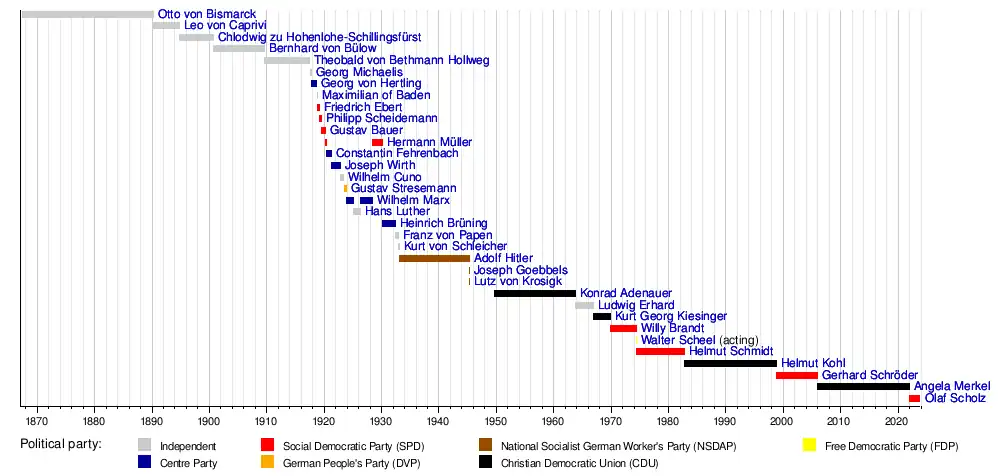
See also
| This article is part of a series on the |
| Politics of Germany |
|---|
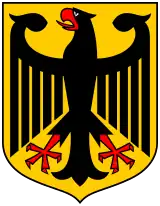 |
References
- "Neuland Grundgesetz | Abkehr von Weimarer Verfassung – Reaktion auf Nazi-Deutschland" [Virgin Soil "Basic Law" | Departure from Weimar Constitution - Reaction to Nazi Germany] (in German). Bundeszentrale für politische Bildung. 1 September 2008. Retrieved 13 March 2018.
- "Tasks of the Federal Chancellor". bundeskanzlerin.de. The Press and Information Office of the Federal Government. Retrieved 13 March 2018.
- [North German Constitution] (in German). 26 June 1867 – via Wikisource.
- [Verfassung des Deutschen Reichs]. 16 April 1871 – via Wikisource.
- "The Seeds of Evil: The Rise of Hitler — The Constitution of the Weimar Republic". schoolshistory.org.uk. 2004. Archived from the original on 20 August 2011. Retrieved 13 March 2018.
- "Biografie Friedrich Ebert 1871-1925" [Biography of Friedrich Ebert]. www.dhm.de/lemo (in German). LeMO/Deutsches Historisches Museum. Retrieved 14 March 2018.
- Hosch, William L. (23 March 2007). "The Reichstag Fire and the Enabling Act of March 23, 1933". Britannica Blog. Archived from the original on 11 March 2019. Retrieved 30 March 2017.
- "Entstehung der DDR: Verfassung und Führungsrolle der SED" [Formation of the GDR: Constitution and the SED's Leadership Role]. www.hdg.de/lemo (in German). LeMO/Haus der Geschichte. Retrieved 14 March 2018.
- "Vertrag zwischen der Bundesrepublik Deutschland und der Deutschen Demokratischen Republik über die Herstellung der Einheit Deutschlands (Einigungsvertrag)" [Unification Treaty between the Federal Republic of Germany and the German Democratic Republic]. Treaty of 31 August 1990 (in German). Retrieved 13 March 2018.
- Jörges, Hans Ulrich; Wüllenweber, Walter (25 April 2007). "CDU-Altkanzler: Ludwig Erhard war nie CDU-Mitglied" (in German). Der Stern. Retrieved 8 April 2018.
.jpg.webp)
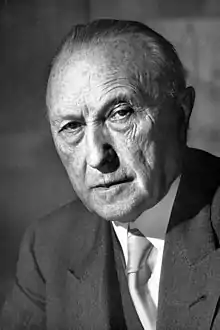
_cropped.jpg.webp)

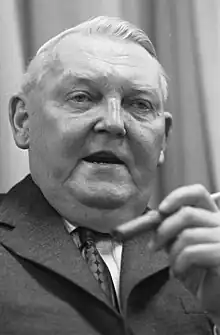
.jpg.webp)
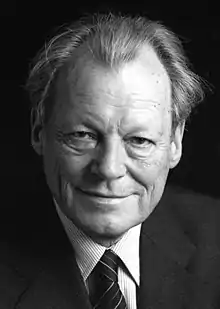
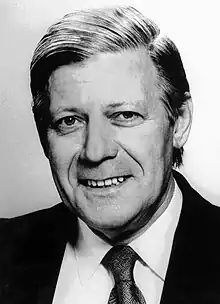
.jpg.webp)
.jpg.webp)